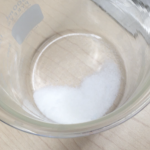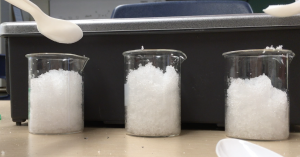Last year when I was teaching Chemistry 12 (SCH4U) I borrowed two of Aletheia’s (@edaigle) unused diapers with which to conduct an experiment. I even dissected one diaper to get ready for the experiment; then life moved on, time ran out, and the diaper strips sat in a beaker in a lab cupboard until today. Yes, it’s true, we undertook a diaper experiment today, and thanks to Aletheia’s generosity, I learned a thing (or two).
As I was preparing for the lab in earnest, reading the instructions closely this time, I was fairly underwhelmed by the substance we were supposed to harvest from the diaper. It said to extract the powder from the batting inside the diaper. I started to dig around in the dissected pieces and I realized there wasn’t a whole lot of powder in there. Would there be enough with which to conduct the experiment (see t=0 seconds image, below left).
Diapers contain sodium polyacrylate, which I never really knew despite having raised two kids of my own through the diaper stage. Diapers work and you don’t ask questions, am I right? Sodium polyacrylate is a polymer that contains sodium ions spread equidistantly throughout. Because of this arrangement it is very good at absorbing water-based liquids, such as urine (and you can learn more about this here). When we added 100 mL of water to the beaker containing a small dusting of this substance it did not take long for all of the water to be absorbed (see images, below).




What the structured inquiry experiment called for next was puzzling to all of us. We divided the expanded polymer into three equal parts and added a scant teaspoon of either calcium chloride, table salt, or table sugar to each of them. What happened next was easily observed, yet not so easily explained. I didn’t know what to expect, and it is only now, after exploring internet sources, that I can make inferences about our observations (see images, below).
What do you notice? What can you infer from what your observations? I look forward to any replies to this blog post as much as I look forward to reading my students’ “Dear Mrs. Farooq” response emails. I told them to write their emails as though I am their daft professor and they are my learned lab technicians. Let’s see how that goes! Thanks for reading!


References:
Carnegie Mellon University. (2016). Gelfand Center. Retrieved from https://www.cmu.edu/gelfand/education/k12-teachers/polymers/polymer-and-absorption/super-absorb-powder.html
Van Kessel, H., and Di Giuseppe, M. (2002). Nelson Chemistry 12. Toronto: Thomson.
Is it because of the sugar expelled in the urine (I know you didn’t actually use urine for this experiment)? I’ll have to go to google to learn a bit more. I know a diaper can hold a lot, as we are only in the toddler years and nights of full diapers are not yet all the way forgotten.